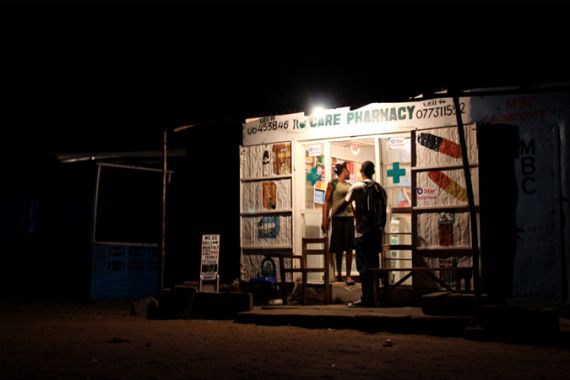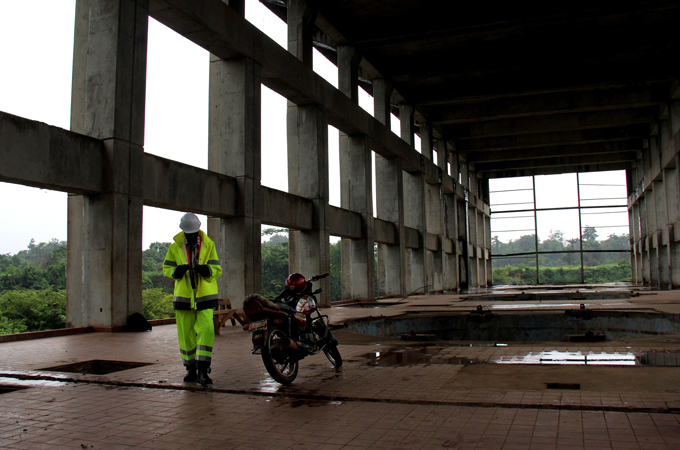Liberia’s long wait to turn on the lights
Only 0.58 per cent of Monrovia residents have access to public electricity, as African nation rebuilds after civil war.

Monrovia, Liberia – Bessi Marshall sits outside her home in near-total darkness. Around her, four young grandchildren huddle close, never venturing more than an arm’s length into the surrounding shadows. Despite living just a few houses back from the main road in Jallah Town, in central Monrovia, Marsha’s family has no electricity. The only light comes from a small cooking fire.
During the night, Marshall fears for her family’s safety. “I can’t sleep,” she says. “I stand at that window and am very afraid.”
In addition to security, Marshall, says that electricity – or current, as it is colloquially called – would let her children devote more time to their studies. In the evenings, one of her older sons, Sekou, goes to the main road to do his homework under a street light connected to the city’s electrical grid. But the traffic there is constant, making the area noisy and unsafe for younger children.
The family owns one small LED flashlight – a “China light”, as Liberians call them. But it doesn’t shine brightly enough to let everybody study at once, and Massa complains that its dim-white glow is painful on her eyes.
“I pray to God for help, for us to get current here,” she says.
Only 0.58 per cent of the residents of this West African country have access to public electricity, according to a 2011 World Bank report. Outside the capital city, public power is practically unheard of. Those who do have access to the Liberian capital’s electrical grid pay $0.43 per kilowatt-hour (kWh), likely the highest rate in sub-Saharan Africa. The majority of businesses and some private homes run on diesel generators that carry a price of $3.96/kWh.
 |
| Damaged during Liberia’s civil war, the Mount Coffee Hydropower Plant is scheduled to reopen by 2015 [Travis Lupick/Al Jazeera] |
Liberia’s energy sector was devastated by 14 years of civil conflict that only ended in 2003. Warlords deliberately targeted electrical infrastructure. The capital city was repeatedly the site of battles that left scars still visible today. And in the years of shaky peace that immediately followed the war, looters stripped bare anything that wasn’t already destroyed.
Nearly a decade later, there are signs that the government of President Ellen Johnson Sirleaf is finally making good on a 2006 promise to “bring back electricity”.
The connectivity rate is on the rise, and ambitious targets have been set. The 2009 Liberia National Energy Policy states that by 2015, the government expects 30 per cent of the country’s urban population and 15 per cent of those living in rural areas to have “reliable modern energy services”. And in a January 2012 address made shortly after Sirleaf was re-elected to a second term in office, she reaffirmed her administration’s commitment to restore electricity to Liberia.
Sceptical residents
But Monrovia residents say that they have heard it all before. Asked about the wait for electricity, they recalled a pledge “to turn on the lights” made by US legislator Nancy Pelosi during a visit to Liberia in 2006, or aborted negotiations with Brazilian firm Vale that attracted media attention in February 2011.
Now, hopes rest on plans to rehabilitate the Mount Coffee Hydropower Plant, which sits on the St Paul River less than 35km from Monrovia. If restored to pre-war conditions by the government’s stated goal of 2015, Mount Coffee’s expected 64 megawatts of electricity would significantly reduce the price of electricity in Liberia. The governments of Norway and Germany and the European Investment Bank (EIB) have announced plans to finance the project. But, even if the money were to arrive tomorrow, several officials interviewed said that a 2015 completion date is unrealistic.
At an interview at his office in Monrovia’s bustling Waterside neighbourhood, Shahid Mohammed, CEO of the Liberia Electricity Corporation (LEC), said that a conversation about the state of electrical infrastructure in Liberia must begin with an explanation of the damage inflicted during the war.
“Nothing was left. Not even a piece of metal,” he said. “Cables, conductors, transformers, substations, meters – we literally lost everything.”
By 2006, modest efforts to rebuild basic services had begun. But it wasn’t until July 2010 that LEC – which is run by Manitoba Hydro International, a Canadian company – started work on the major reconstruction programme that is continuing today, Mohammed noted.
Since then, progress has been made, he said. Huge diesel generators supply the public grid with 22 MW of electricity, up from nine when LEC took over. Twelve large government buildings are connected, and other public facilities such as hospitals and some schools are also receiving public power. LEC’s customer base has grown from fewer than 2,000 consumers in 2010 to more than 6,000 today. And there is now a push under way to connect an additional 16,500 households in 21 low-income neighbourhoods around Monrovia by 2015, Mohammed said.
When it has run its course, the project, which is financed by the Global Partnership on Output-Based Aid (GPOBA) and administered by the World Bank, is expected to benefit 80,000 people.
But with more than one million people estimated to live in Monrovia, that’s an access rate of only eight per cent – still far below the 2011 West African regional average of 28.5 per cent, according to World Bank figures.
In Jallah Town, one of the neighbourhoods listed in the GPOBA project, Boakai Rogers, an assistant manager at Sentora Shop, said that the property recently switched from a diesel generator to LEC-supplied electricity, and that the savings were immediately felt.
Sentora Shop is running its coolers more often than before, so drinks stay cold, Rogers said. And while competitors sell soft drinks for 35 Liberian dollars ($0.47), he can sell for LD$30 ($0.40). The obvious result has been an increase in customers, Rogers added.
Generators as lifeline
However, a more common reaction to news of the GPOBA project was that of Rebecca Kamara, a nurse and the manager of Jallah Town’s Cure Pharmacy.
At 9:00pm, the lights were still on inside the small drugstore – but only thanks to a noisy generator that hummed outside the building’s front door.
| Liberia seals Ivorian border after attack |
“It’s expensive. But what you do?” she asked. “We get only a little profit and we spend that much every day on the generator.”
Kamara says that her pharmacy is the only one in the community to stay open so late. But when the generator runs out of fuel or breaks, she is forced to close.
Mohammed Sherif, chief economist at the Liberia Ministry of Finance, argued that perceived delays in the rehabilitation of the country’s electrical grid fail to take the context of a nation rebuilding itself into account. He explained that the Sirleaf administration spent much of its first term in office re-establishing institutional foundations such as accounting standards and other government systems that large infrastructure projects require.
“Significant intervention was made,” Sherif said. “But it was made on an emergency basis. That was an emergency. Now we are going into a recovery.”
He maintained that while donor funding for the rehabilitation of the Mount Coffee facility has failed to materialise before, Norway, Germany, and the EIB have committed more than $165m for the project. In addition, Sherif continued, the government of Liberia has allocated more than $45m for investment in the energy sector in its budget for 2013.
‘Big light tomorrow’
He recalled that the during Sirleaf’s first term in office, the line on energy was: “Small light today, big light tomorrow.”
“Now big light is coming with Mount Coffee and the subsequent dam we are supposed to develop.”
Inguna Dobraja, Liberia’s country manager for the World Bank, also said that financing is on track to see Liberia’s energy infrastructure receive the overhaul that the country’s people have been waiting for
“My impression is that the government is in the driver’s seat and that they are committed to implementing this programme,” she said.
The challenge is human capacity, Dobraja added. “There is a need to have local Liberians working and installing those poles and meters. Currently, it’s really not happening. A lot of people who are doing the implementation work are coming from Ghana or Kenya,” Dobraja said.
Standing in the main hall of the Mount Coffee Hydropower Plant, one is struck by the scale of destruction from which Liberia is rebuilding itself.
|
“My wife, she is still going to school at night, studying on a China light. It is embarrassing. However, we did it to our self. And we just have to ask God to forgive us. This is the process that we are in.” – Goodrich Zodehgar |
Huge plate glass windows were long ago smashed to expose sharp drops to the river below. The lower levels of the facility are flooded and inaccessible. Pockmarked concrete walls reveal that even the dam’s inner copper wiring has been stripped out, piece by piece.
Goodrich Zodehgar, the facility’s security supervisor and an electrician by trade, recalled the first time he visited the power plant, in 1979.
“It was very wonderful to see,” he said. “It was like a tourist site … people would pay a visit, take a picture, and bring their family to see the view of the dam and the reservoir.”
Zodehgar said that it was his dream to one day work at Mount Coffee, not as a security guard, but as a technician. His wife and children stay in Monrovia where they live without electricity and only one battery-powered LED light to share among them. It is families like his own for whom he wants to see his dream fulfilled.
“My wife, she is still going to school at night, studying on a China light,” he said. “It is embarrassing. However, we did it to our self. And we just have to ask God to forgive us. This is the process that we are in.”
Follow Travis Lupick on Twitter: @tlupick